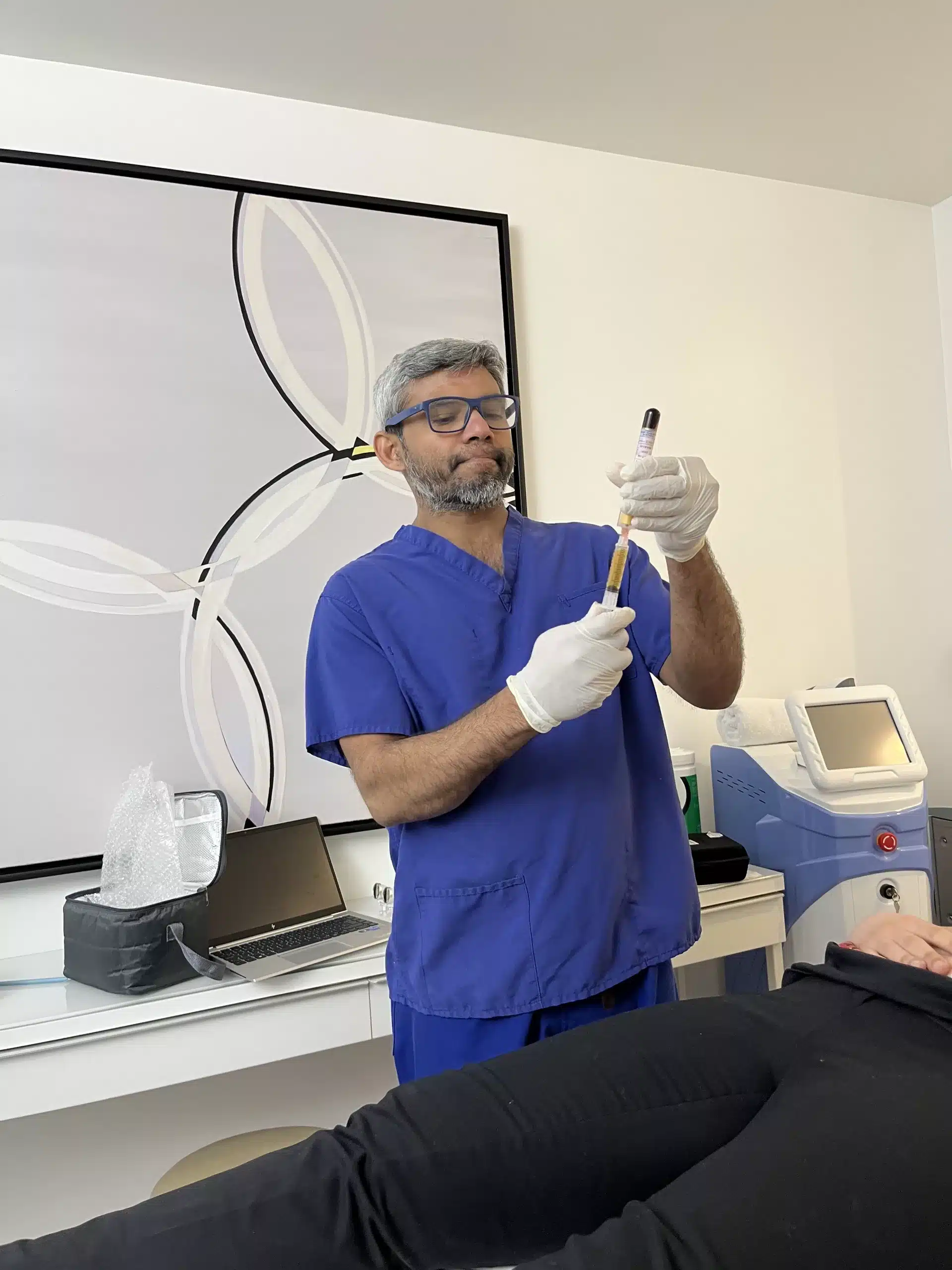
PRP (Platelet-Rich Plasma) at Santi London
A regenerative treatment using a concentrate of your own blood platelets to support repair and improve skin quality or hair density. Calm, clinician-led care in South Kensington.
What is PRP?
Your own biology
PRP is prepared from a small blood draw. Centrifugation concentrates platelets and growth factors which are then placed precisely into target areas.
Skin quality focus
Used to improve texture, fine lines, crepiness and tone by supporting tissue repair processes.
Hair/scalp applications
Can help thinning hair by supporting follicle environments in appropriate candidates.
Course-based plan
Best results typically follow a series of sessions with periodic maintenance; personalised after assessment.
What to expect at Santi
Clinical assessment
We review medical history and goals, confirm suitability, and explain expected ranges and alternatives.
Preparation & placement
A small blood draw is processed; PRP is placed via fine needles or cannula across the treatment area (skin or scalp).
Aftercare & review
Mild redness/tenderness is common and settles quickly. You’ll receive written aftercare and an optional review to refine your plan.

Common treatment areas
*Peri-orbital use depends on individual assessment and technique.
Typical course & timeline
Initial course
- Commonly 3 sessions, ~4–6 weeks apart (case-dependent).
- Early freshness may be noticed after the first sessions; effect builds progressively.
Maintenance
- Top-ups typically every 6–12 months for skin; 3–6 months for scalp (varies by goals/response).
- Your clinician will tailor intervals to your needs.
Safety, suitability & aftercare
Common effects
Mild redness, swelling or tenderness; occasional bruising at injection sites. Usually settle within a few days.
Contra-indications
Active infection/inflammation at the site, certain blood disorders, pregnancy/breastfeeding and specific medications/medical conditions. We’ll screen this with you.
Aftercare basics
Keep area clean; avoid heavy exercise/saunas/alcohol the first day; follow your written guidance. Contact us with any concerns.
PRP
Increasingly popular, PRP (Platelet-Rich Plasma) introduces your own blood product back into skin or scalp to help kick-start cell activity, support healing and calm inflammation. Because it’s autologous, PRP avoids allergic reactions and keeps downtime low.
PRP for Skin
From £500 (or £750 with HA). Sometimes nicknamed a “vampire facial,” PRP is prepared from a small blood draw, then placed with or without microneedling. Growth factors signal collagen synthesis and cell turnover to refine texture, pores and fine lines.
The science in brief
Platelet alpha-granules release signalling proteins such as PDGF, TGF-β, VEGF, EGF and IGF. These factors bind to cell receptors, triggering cascades that support matrix production (e.g., collagen), angiogenesis, and tissue repair. Outcomes vary by indication, technique and individual biology.
Is PRP suitable for all skin tones?
Generally suitable across skin tones; final suitability is confirmed at consultation after medical screening.
Does PRP replace fillers or lasers?
Different tools: PRP supports regeneration and quality; fillers add volume/shape; lasers resurface. We’ll advise the right mix for your goals.
Does it hurt?
We use topical anaesthetic where appropriate. You’ll feel brief pinpricks/pressure; most clients tolerate this well.
When will I see results?
Skin: freshness often within weeks; quality builds across a course. Scalp: expect a gradual trajectory over months.
Related PRP Guides
What Is PRP and How Does It Work?
Understand the mechanism behind platelet-rich plasma therapy — how it’s prepared, why it works, and where it fits in regenerative aesthetics.
The Science Behind PRP Therapy
Explore the growth factors and cellular signalling processes that make PRP a regenerative cornerstone for both skin and scalp treatments.
How to Prepare for Your PRP Treatment
Pre-treatment and post-treatment guidance to help optimise comfort, healing and long-term results from your PRP sessions.
Is PRP Hair Restoration Right for You?
Find out whether PRP is suitable for your stage and pattern of hair thinning — and what to expect during the consultation process.
Pre & Post-Treatment Care Following PRP
Detailed aftercare steps, what to avoid, and how to maintain skin or scalp health after your PRP procedure at Santi London.
Understanding Male Pattern Baldness & PRP
Learn how PRP can support follicle vitality in male pattern thinning and where it fits in a broader hair restoration plan.
